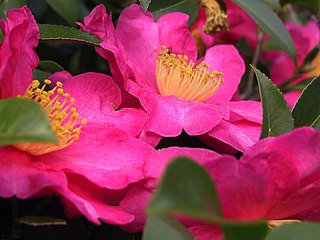
Camellia is a genus of flowering plants in the family Theaceae. They are found in eastern and southern Asia, from the Himalayas east to Japan and Indonesia. There are 100–300 described species, with some controversy over the exact number. There are also around 3,000 hybrids. The genus was named by Linnaeus after the Jesuit botanist Georg Joseph Kamel, who worked in the Philippines and described a species of camellia. Camellias are famous throughout East Asia; they are known as cháhuā in Chinese, tsubaki (椿) in Japanese, dongbaek-kkot (동백꽃) in Korean, and as hoa trà or hoa chè in Vietnamese.

The peony or paeony is a flowering plant in the genus Paeonia, the only genus in the family Paeoniaceae. Peonies are native to Asia, Europe and Western North America. Scientists differ on the number of species that can be distinguished, ranging from 25 to 40, although the current consensus is 33 known species. The relationships between the species need to be further clarified.

Hibiscus syriacus is a species of flowering plant in the mallow family, Malvaceae. It is native to south-central and southeast China, but widely introduced elsewhere, including much of Asia. It was given the epithet syriacus because it had been collected from gardens in Syria. Common names include the Korean rose, rose of Sharon, Syrian ketmia, shrub althea, rose mallow. It is the national flower of South Korea and is mentioned in the South Korean national anthem.
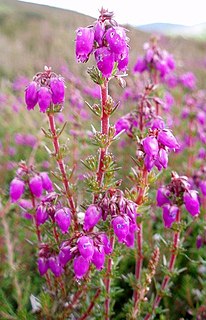
Erica cinerea, the bell heather, is a species of flowering plant in the heath family Ericaceae, native to western and central Europe.

Erica carnea, the winter heath, winter-flowering heather, spring heath or alpine heath, is a species of flowering plant in the family Ericaceae, native to mountainous areas of central, eastern and southern Europe, where it grows in coniferous woodlands or stony slopes.

Paeonia lactiflora is a species of herbaceous perennial flowering plant in the family Paeoniaceae, native to central and eastern Asia from eastern Tibet across northern China to eastern Siberia.

Cornus alba, the red-barked, white or Siberian dogwood, is a species of flowering plant in the family Cornaceae, native to Siberia, northern China and Korea. It is a large deciduous surculose (suckering) shrub that can be grown as a small tree. As a popular ornamental used in landscaping its notable features include the red stems in fall (autumn) through late winter, the brightest winter bark of any cornus; and the variegated foliage in some cultivars, such as C. alba 'Elegantissima', in which the discreet flat whitish flower clusters are almost lost in the variegated texture and dappled light. C. alba can grow to 3 m (10 ft) high, but variegated forms are less vigorous. For the brightest winter bark, young shoots are encouraged by cutting to the ground some older stems at the end of the winter, before leaves are open. The oval fruits are white, sometimes tinted blue.

Schefflera actinophylla is a tree in the family Araliaceae. It is native to tropical rainforests and gallery forests in northern and north-eastern Queensland coasts and the Northern Territory of Australia, as well as New Guinea and Java. Common names include Australia umbrella tree, Queensland umbrella tree, octopus tree and amate.

Oxypetalum coeruleum is a species of flowering plant, native to South America from southern Brazil to Uruguay. The synonymous name Tweedia caerulea is also used. Growing to 100 cm (39 in) long, it is a straggling evergreen perennial with heart shaped, gray-green, downy leaves. It is grown for its clear pale blue, star-shaped flowers, which are long lasting and cut well. The summer flowers age to purple and are followed by 30 cm (12 in) long, boat-shaped seed pods. The seeds have downy parachute-like tufts (cypsela).

Plumbago auriculata, the cape leadwort, blue plumbago or Cape plumbago, is a species of flowering plant in the family Plumbaginaceae, native to South Africa.
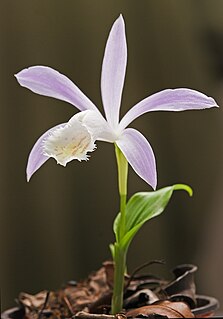
Pleione formosana, the Taiwan pleione or windowsill orchid, is a species of flowering plant in the family Orchidaceae, native to southeastern China as well as northern and central Taiwan. It is a deciduous perennial, terrestrial orchid growing to 15 cm (6 in) tall by 30 cm (12 in) wide, with spherical pseudobulbs that produce a single folded leaf. The pink flowers, borne in spring, have fringed white lips that are strongly marked and mottled with brown on the inner surface.

Hydrangea serrata is a species of flowering plant in the family Hydrangeaceae, native to mountainous regions of Korea and Japan. Common names include mountain hydrangea and tea of heaven. Growing to 1.2 m (4 ft) tall and broad, it is a deciduous shrub with oval leaves and panicles of blue and pink flowers in summer and autumn (fall). It is widely cultivated as an attractive ornamental shrub throughout the world in areas with suitable climate and soil.

Sarcococca confusa, the sweet box, is a species of flowering plant in the family Buxaceae, probably native to western China. It is an evergreen shrub growing to 2 m (7 ft) tall by 1 m (3 ft) broad, with glossy green ovate leaves and honey-scented white flowers in winter, followed by glossy black spherical fruits, 5 mm in diameter.
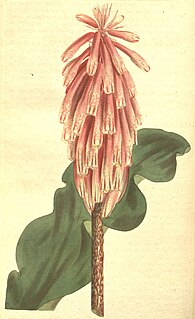
Veltheimia capensis is one of two species of flowering plants belonging to the genus Veltheimia, of the family Asparagaceae. It is a tender bulbous perennial reaching a height of 46 cm (18 in), with flowers varying in color from white with red spots to pink with green or red markings.

Iris aucheri, the Aucher-Éloy iris, is a species of flowering plant in the family Iridaceae. It is a bulbous perennial in the Juno group of irises.

Artemisia arborescens, the tree wormwood, is a species of flowering plant in the family Asteraceae, native to the Mediterranean region. It is an erect evergreen perennial, with masses of finely-divided aromatic silvery-white leaves and single-sided sprays of yellow daisy-like flowers. This plant is cultivated for its foliage effects, but in colder temperate regions it requires the protection of a wall.

Artemisia schmidtiana, common name silvermound, is a species of flowering plant in the family Asteraceae, native to Japan but widely cultivated as an ornamental.
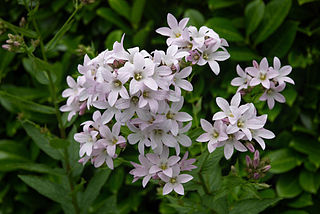
Campanula lactiflora, the milky bellflower, is a species of flowering plant in the genus Campanula of the family Campanulaceae, native to Turkey and the Caucasus. It is a medium-sized herbaceous perennial growing to 1.2 m, with narrow, toothed leaves 5–12 cm (2–5 in) long. Large conical clusters of open, star-shaped flowers are produced on branching stems in summer. In favourable conditions it will self-seed with variable results. The flowers are usually white or pale blue, but numerous cultivars have been developed for garden use, in a range of colours.

Erinacea anthyllis, the blue broom, hedgehog plant, or rushy kidney vetch, is a species of flowering plant in the legume family Fabaceae. It is native to stony mountainous places in the Pyrenees, the Mediterranean and Morocco. It is a dwarf, spiny, evergreen shrub growing to a dome shape 30 cm (12 in) tall and wide. It has dense foliage, and lilac coloured pea-like flowers in late spring and early summer.

Ranunculus calandrinioides, the high alpine buttercup, is a species of flowering plant in the family Ranunculaceae, native to the Atlas Mountains of North Africa. Growing to 20 cm (8 in) tall by 15 cm (6 in) broad, it is an herbaceous perennial with broad, grey-green leaves which die down in summer, and white flowers, often tinged with pink, in winter and spring. It is one of the earliest buttercups to flower.




















